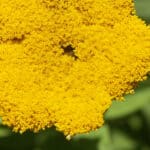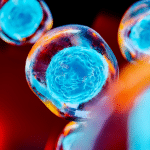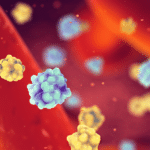2-arachidonoylglycerol
2-AG is present in human breast milk, and thought to be vital in regulating pain, appetite, memory formation, and immune function. The second endocannabinoid to be discovered, 2-AG is more commonly expressed in mammalian systems than AEA.
Acid cannabinoids
Cannabis flowers produce phytocannabinoids in their raw, unheated, forms. These forms have an extra chemical group, called a carboxyl group, that makes the cannabinoid slightly larger than the more familiar, ‘activate’, forms (like Δ9-THC and CBD). This group means that acid cannabinoids are metabolized in different ways by the body, and don’t necessarily cause the same effects as their ‘active’ counterparts.
Agonist
A chemical that binds to a receptor and increases its activity. Agonists are classified by the way they interact with their receptor. There are direct (orthosteric) agonists, indirect (allosteric) agonists, and biased agonists, for example.
Allosteric modulator
A chemical that increases or decreases the strength of the signal a receptor sends into the cell. Allosteric modulators affect constitutive activity and agonists, but their effect will not necessarily be the same for all agonists of a receptor.
Anandamide
Also known as the ‘bliss molecule’ anandamide is responsible for the feeling of a runner’s high. In 1993, it made history as the first identified endocannabinoid, or cannabinoid produced within our bodies. It’s identification proved that the endocannabinoid system was responsible for more than just mediating the effects of plant-based cannabinoids like THC.
Antagonist
A chemical that binds to a receptor and deactivates, or blocks, its activity.
Binding affinity
The measure of how well a chemical binds to a receptor, which impacts how strongly the cell associated with the receptor reacts.
Broad spectrum
Cannabis products that contains all of the original compounds found in cannabis flower — cannabinoids, terpenes, and flavonoids — and from which tetrahydrocannabinol (THC) has been removed.
Cannabidiol
A common non-intoxicating compound produced by cannabis, with a wide range of medical applications. CBD is the second most commonly produced compound in cannabis varieties bred for their medicinal use, and the most common in varieties bred for agriculture (commonly known as hemp). It is of interest to many people for its medicinal value, especially its anti-epileptic, anti-anxiety, and anti-inflammatory effects.
Cannabidiolic acid
The unheated form of cannabidiol (CBD) that is produced in cannabis flower. See “acid cannabinoids”.
Cannabigerol
All cannabinoids start as CBG. It is a non-intoxicating compound, and of medical interest for pain management and anxiety relief. CBG is often referred to as the ‘parent cannabinoid’. All phytocannabinoids start out as CBG in their developmental processes.
Cannabinoid
Cannabinoids are compounds uniquely found in cannabis plants, as well as compounds similar to those found in cannabis plants. Some cannabinoids interact with the endocannabinoid system. There are three general categories of cannabinoids:
- Phytocannabinoids: Cannabinoids produced by plants.
- Endogenous cannabinoids (endocannabinoids): Cannabinoids produced naturally by living animals, including humans, that interact with the body’s endogenous cannabinoid (endocannabinoid) system.
- Synthetic cannabinoids: Cannabinoids produced by humans in a laboratory.
Cannabinoid Receptor Type 1
Found primarily in the central nervous system, CB1R are responsible for the feeling of intoxication, or ‘high’, when consuming THC.
Cannabinoid Receptor Type 2
Found throughout the immune system, the peripheral nervous system, and the gastrointestinal system, CB2R are of interest for immunomodulatory action.
Cannabinol
The oxidized (aged) form of THC. CBN is a weaker version of THC. When Δ9-THC oxidizes, which happens as cannabis ages, it degrades into CBN. CBN has about 25% the intoxicating ability as Δ9-THC. Many have attributed sedative effects to CBN, but these claims are not substantiated by scientific literature.
COX-1
Cyclooxygenase 1 is an enzyme that our bodies create to help form new blood vessels on the interior surface of blood and lymph vessels, and protect the mucus lining in the inner stomach by reducing acid secretion. It plays a role in maintaining our bodies’ optimal functioning.
COX-2
Prostaglandin-endoperoxide synthase 2 is an enzyme that plays a role in our body’s ability to create inflammation.
Decarboxylation
The process of adding heat to raw cannabinoids in order to activate them. Decarboxylation is the process of removing a carboxyl group, a group of compounds composed of a carbon double bonded to an oxygen and an OH bonded to that same oxygen. This process is necessary to activate the cannabinoids found in plants. It happens as a result of heat and time.
Distillate
A cannabis product produced by removing everything except for a specific cannabinoid, generally THC or CBD.
Endocannabinoid system
The ECS regulates many systems within the body, and mediates the effects felt by consuming some cannabinoids (like THC). The endocannabinoid system is present in the bodies of all mammals that includes cannabinoid receptors, endogenous agonists, and metabolites of those compounds. It is helps regulate many systems within the body.
Extract
A concentrated cannabis product most commonly produced by using a solvent like CO2, alcohol, or butane. Solventless extracts are also popular, produced by mechanically separating the trichomes from the flower (a.k.a. hash, rosin). Solventless methods of extraction aim to seperate and collect the oil-rich trichomes from cannabis flower. Solvent-based extraction methods use a solvent (CO2, alcohol, oil, hydrocarbons) to seperate the oil.
Full spectrum
Cannabis products that contain all of the original compounds found in cannabis flower: cannabinoids, terpenes, and flavonoids. Cannabis flower naturally contains hundreds of active compounds. The diverse combination of compounds is thought to contribute to the specific effects felt when consuming cannabis flower. Full-spectrum products preserve as much of this chemical diversity as possible.
G-Protein Coupled Receptor
The oldest and largest group of receptors in living organisms. Endocannabinoid receptors CB1 and CB2 are members of this group.
Hemp
A legal term that refers to cannabis varieties that produce less than 0.03% THC in a mature flowering plant. It is often used to refer to varieties that have been bred for agricultural purposes. Cannabis that has traditionally been bred for food or fiber. Hemp is a legal, and not taxonomic, definition. Legally, hemp is differentiated from cannabis based on the amount of THC it produces. In order for a variety of cannabis to be considered hemp in most of the world, it’s flowers must produce less than 0.03% THC by dry weight.
Indica
Colloquial term that describe varieties of cannabis that have relaxing effects.
Isolate
A cannabis product produced by refining oil extracted from cannabis flower. Isolate may have trace amounts of other cannabinoids and other plant compounds present.
Ligand
Compounds that bind to a specific receptor are that receptor’s ligands.
N-acyl-ethanolamines
An endogenous molecule with a structure similar to anandamide. A class of endogenous molecules where a fatty acid is attached to an ethanolamine molecule. Anandamide, OEA, and PEA are the most well study. They are implicated in appetite and obesity.
Receptor
Tiny proteins on the surface of most cells. Receptors act as the ‘go-buttons’ on cells, and when activated by compounds that fit into them, tell the cell what to do or not do.
Sativa
Colloquial term that describe varieties of cannabis that have energizing effects.
Terpene
Aromatic compounds found in most plants and some insects. Terpenes are responsible for the way cannabis smells, and have been associated with the distinct effects it can produce.
Tetrahydrocannabinol
The compound in cannabis responsible for its intoxicating, and many of its medical, effects. The most common compound produced in cannabis varieties that have been bred for recreational and medicinal use.The activated form of THC, Δ9-THC, causes the intoxicating feelings generally associated with consuming cannabis and being ‘high’. THC causes intoxication by binding to the CB1 receptor in our bodies. It also binds to the CB2 receptor and stimulates our immune system. Mnemonic device: The High Causer.
Tetrahydrocannabinolic acid
The unheated form of tetrahydrocannabinol (Δ9-THC) that is produced in cannabis flower. See “acid cannabinoids.”
Trichome
The hair-like outgrowths that cover cannabis flowers and smaller leaves. Trichomes are where cannabinoids and terpenes are produced.
Varin cannabinoids
Sometimes instead of a precursor compounds combining to create cannabigerol (CBG), the parent cannabinoid, slightly different compound combine to create a -varin cannabinoid. There are two fewer carbon atoms in a varin cannabinoid, and the effects from them are very different. Tetrahydrocannabivarin (THCV) and cannabidivarin (CBDV) are of medical interest for a number of different conditions.







